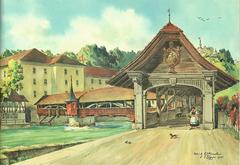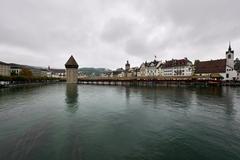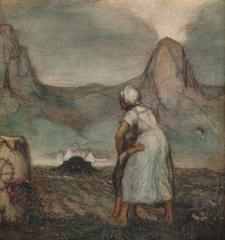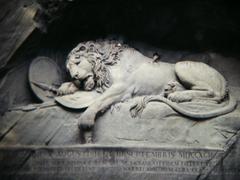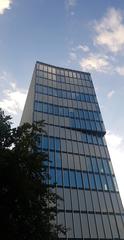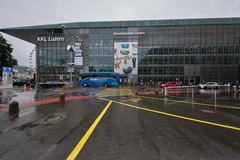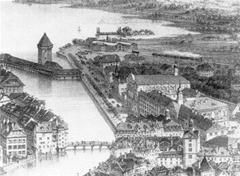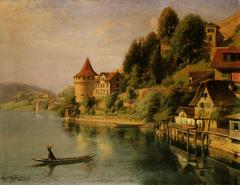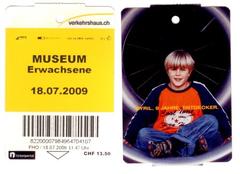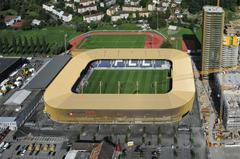
Spreuerbrücke Chapel Lucerne: Visiting Hours, Tickets, and Travel Guide
Date: 14/06/2025
Introduction
Nestled in the heart of Lucerne, Switzerland, the Spreuerbrücke Chapel stands as a captivating symbol of the city’s medieval heritage and artistic legacy. Built in 1408, this covered wooden bridge was originally vital to the city’s milling economy and has evolved into a cherished cultural landmark. Most renowned for its extraordinary collection of Totentanz (Dance of Death) paintings, the Spreuerbrücke offers visitors not only architectural beauty but also a thought-provoking journey through art and history.
Accessible 24/7 and free to enter, the Spreuerbrücke is an essential stop for anyone exploring Lucerne’s Old Town. Its robust timber construction and the small, integrated chapel dedicated to St. Mary provide an atmospheric setting for the cycle of Dance of Death paintings by Kaspar Meglinger and his workshop. These 17th-century panels vividly depict mortality’s universality, making the bridge a place of reflection and insight into Swiss religious and social history.
This comprehensive guide covers the Spreuerbrücke’s origins, architecture, artistic highlights, practical visiting details, and tips to enhance your experience. Whether you are a history enthusiast, art lover, or curious traveler, the Spreuerbrücke stands ready to enrich your understanding of Lucerne’s vibrant past.
For further information, see Nomads Travel Guide, Tripoto, and the official Lucerne tourism website.
Table of Contents
- Introduction
- Origins and Historical Development
- Cultural and Artistic Significance
- Visiting Spreuerbrücke: Practical Information
- Preservation and Heritage Status
- Visitor Experience and Interpretation
- Architectural and Artistic Features
- Decorative Elements and Urban Integration
- Visitor Information and Tips
- Notable Comparisons: Spreuerbrücke vs. Chapel Bridge
- Frequently Asked Questions (FAQ)
- Conclusion and Resources
Origins and Historical Development
Medieval Context and Construction
The Spreuerbrücke (Spreuer Bridge) is one of Lucerne’s oldest covered wooden bridges, dating back to 1408 (Nomads Travel Guide). Its name derives from the German word “Spreu” (chaff), reflecting its historical use as the only bridge from which millers could legally dump chaff and leaves into the Reuss River—an essential aspect of Lucerne’s medieval economy.
Strategically, the bridge connected key areas of the city, linking mills on both sides of the river and integrating Lucerne’s commercial and residential districts (CIO Women Magazine). Its construction reflects the Swiss tradition of robust timber bridges, designed to withstand the river’s currents and frequent floods.
Cultural and Artistic Significance
The Dance of Death Paintings
The Spreuerbrücke is most famous for its 67 painted panels, the Totentanz (Dance of Death), created between 1626 and 1635 by Kaspar Meglinger and his workshop (Nomads Travel Guide). These allegorical paintings depict Death interacting with people from all social classes—nobles, clergy, peasants, merchants—reminding visitors of the inevitability of mortality.
Each panel includes explanatory verses in German and the coats of arms of sponsoring families, reflecting 17th-century Lucerne’s religious and social values. The paintings were added during the Counter-Reformation, reinforcing Catholic teachings about the transience of earthly life.
Religious and Social Context
At the midpoint of the bridge stands a modest chapel dedicated to St. Mary, seamlessly integrated with the bridge’s architecture. The chapel’s presence highlights the blending of civic and religious functions in Lucerne’s public spaces, serving as a spiritual waypoint for travelers and townsfolk alike (Maddy’s Avenue).
Visiting Spreuerbrücke: Practical Information
- Visiting Hours: Open 24/7 year-round; accessible at any time.
- Tickets: No admission fee; entry is free.
- Accessibility: Most of the bridge is wheelchair accessible, though some areas may have uneven floorboards. Caution is advised during wet weather.
Travel Tips
- Visit early morning or late evening for a quieter experience.
- Combine your visit with the Chapel Bridge, Musegg Wall, and Lucerne’s Old Town.
- Guided tours and audio guides are available for deeper insight (Nomads Travel Guide, Luzern.com).
Preservation and Heritage Status
The Spreuerbrücke is recognized as a Swiss cultural property of national significance. It has survived floods, fires, and centuries of wear, with ongoing restoration efforts focusing on both its structure and the preservation of the Dance of Death panels (CIO Women Magazine). Modern conservation uses traditional carpentry and advanced restoration techniques to maintain authenticity.
Visitor Experience and Interpretation
Informative plaques in multiple languages explain the bridge’s history and the meaning behind the paintings. Guided tours and audio guides, often starting at the History Museum, provide additional context. Photography is permitted, but use of flash is discouraged to protect the artwork.
Architectural and Artistic Features
Covered Wooden Bridge Construction
The Spreuerbrücke is a classic example of medieval Swiss bridge engineering. Its truss-style structure spans 81 meters over the Reuss River, with stone piers anchoring robust timber beams (Tripoto). The covered walkway shelters both pedestrians and the artwork from the elements, while the wooden shingles and decorative balustrades add rustic charm.
The Chapel Integration
The small chapel at the bridge’s midpoint is a unique architectural feature, its simple timber structure harmonizing with the bridge’s design and serving as a reminder of the city’s spiritual traditions.
Totentanz Artistic Cycle
The Dance of Death paintings, mounted in triangular frames under the roof, are executed in a vivid late Renaissance style. Death is personified as a skeleton, interacting with individuals from all social classes, often with symbolic objects—scythes, hourglasses, decaying flowers—underscoring life’s impermanence (Tripoto).
Decorative Elements and Urban Integration
Timber joinery, mortise-and-tenon joints, and decorative carvings showcase medieval craftsmanship. The bridge’s covered walkway frames scenic river and city views, making it a favorite spot for photography and contemplation (Tripoto).
Visitor Information and Tips
- Allow at least 30–45 minutes to cross the bridge and appreciate the paintings.
- Wear footwear suitable for wooden surfaces, especially in wet weather.
- The bridge is close to public restrooms, cafés, and other amenities in the Old Town (Biche Around the World).
- For a comprehensive experience, consider a walking itinerary that includes the Chapel Bridge, Jesuit Church, and Musegg Wall.
Notable Comparisons: Spreuerbrücke vs. Chapel Bridge
While the Chapel Bridge (Kapellbrücke) is more famous, the Spreuerbrücke offers a more intimate setting and the most complete Dance of Death painting cycle in Europe. Both bridges exemplify Lucerne’s dedication to preserving its medieval architectural and artistic heritage (Kapellbruecke.com).
Frequently Asked Questions (FAQ)
Q: What are the Spreuerbrücke visiting hours?
A: The bridge is open 24/7, year-round.
Q: Is there an entrance fee or ticket required?
A: No, entry is free.
Q: Is the bridge wheelchair accessible?
A: Most of the bridge is accessible, though some uneven surfaces and steps may be present.
Q: Are guided tours available?
A: Yes, audio guides and guided walking tours can be booked (Luzern.com).
Q: What else is nearby?
A: Chapel Bridge, Jesuit Church, Musegg Wall, and Lucerne’s Old Town.
Conclusion
The Spreuerbrücke Chapel is more than a bridge—it is a living monument to Lucerne’s medieval past, religious traditions, and artistic achievements. Its free, year-round accessibility and proximity to other city highlights make it an essential stop for any visitor. Plan your visit to experience the evocative Dance of Death cycle, marvel at medieval craftsmanship, and immerse yourself in the living history of Lucerne.
For up-to-date travel information and event details, visit the official Lucerne tourism website. Download the Audiala app for audio guides and explore related articles for more on Lucerne’s historic sites.
